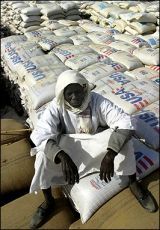International aid effort stabilizes Darfur malnutrition – UN
Oct 19, 2006 (KHARTOUM) — Despite the deteriorating security situation in Darfur, a new United Nations assessment has found that overall malnutrition levels have mostly stabilized in 2006 and food insecurity has improved slightly thanks to a stronger international response to the suffering in Sudan’s war-torn west.

|
|
A displaced Sudanese man guards humanitarian aid from the World Food Program at Kalma refugee camp near Nyala town in Sudan’s south Darfur region. |
According to a joint press statement released by the FAO, UNICEF and WFP, crude mortality dropped for the third year running, but insecurity and lack of access to many Darfurians continued to cloud the aid picture.
The assessment also found that while the malnutrition rate among children under five rose slightly, from 11.9 percent last year to 13.1 percent this year, hovering just beneath the emergency threshold of 15 percent, it remained significantly below the 2004 malnutrition rates in Darfur which stood at 21.8 percent.
UN humanitarian agencies and non-governmental organizations have been able
to deliver life-saving services including food aid, clean water, health
services and agricultural assistance. However, the condition of those in
greatest need remains very precarious.
Preliminary results of the joint assessment by the United Nations Food and
Agriculture Organization, UNICEF and the World Food Programme found that 70
percent of war-affected Darfurians were food insecure, slightly down from
74 percent last year. While the remaining 30 percent of this year’s
war-affected people required some form of assistance, they had more diverse
diets, spent less than 50 percent of their income on food and relied less
on food aid.
But the UN agencies cautioned that the continued flow of aid is under
threat because of escalating violence, which is restricting access to war
and drought-affected people, exacerbating the already fragile situation..
Approximately 60 percent of highly food insecure households mentioned
insecurity as the main barrier to cultivating their land, raising livestock
and taking part in other income-generating activities.
The assessment also showed that the percentage of people with adequate
access to food among those living in displacement camps had actually
dropped from 36 percent in 2005 to just 14 percent in 2006.
Furthermore, the number of families who said they could reach feeding
centres for malnourished children had halved as the result of deteriorating
security and because some feeding centres closed after malnutrition figures
improved last year.
The assessment, which sampled households from the 3.7 million receiving
aid, out of the total six million people in Darfur, pointed out some
progress. But due to insecurity and bad weather, the assessment teams were
unable to reach some critical areas where aid has not been received for
several months.
Access to clean water rose from 63 percent to 72 percent, vital to reducing
disease and mortality caused by contaminated drinking water. Also, the food
security of the resident community has improved slightly across Darfur, and
the assessment found a direct connection between food security and people’s
ability to cultivate and generate income.
In North Darfur, where the majority of those covered by the assessment were
residents, food security has improved despite humanitarian access problems
in recent months. But in South and West Darfur, food security declined
because of comparatively higher numbers of displaced people living in
camps, where the majority cannot cultivate.
Across Darfur, 51 percent of families cultivated their land this year, the
same number as last year. State by state, households cultivated 59 percent
in North Darfur, 48 percent in South Darfur and 46 percent in West Darfur.
Beside insecurity, Darfurians said water shortages, lack of tools, pests,
weeds, crop disease and shortage of seeds prevented them from cultivating
more.
The sale of agriculture production was the main source of income for just
20 percent of people in Darfur, while wage labour mostly in agriculture was
the main income source for 37 percent.
The assessment was conducted in September and sampled 2,200 households
across 89 locations in the three states of Darfur. It found that 22 percent
of households were female-headed and that 53 percent of household heads were illiterate.
(FAO/UNICEF/WFP/ST)
